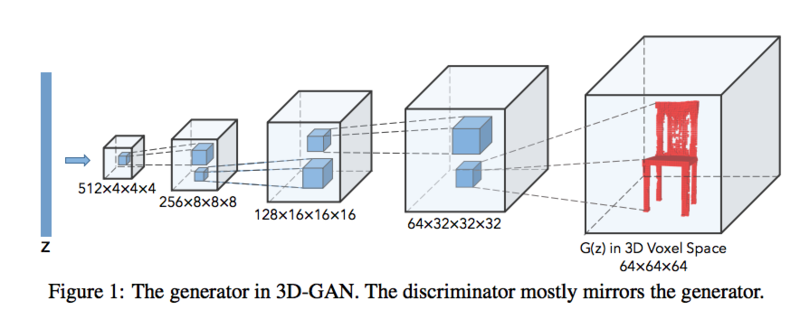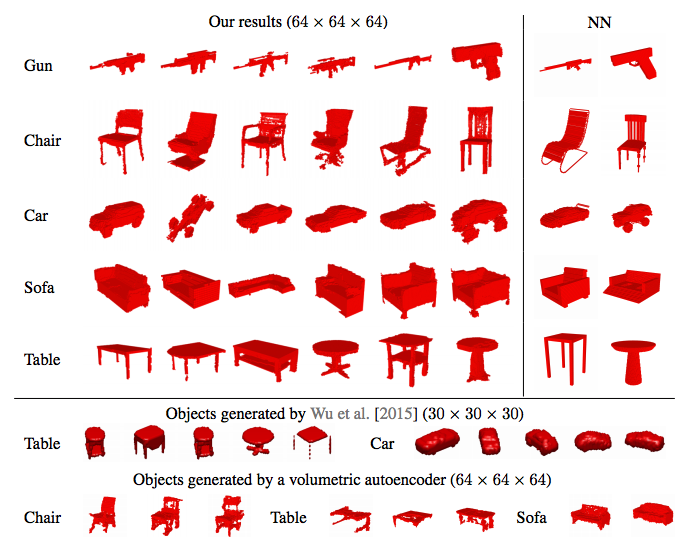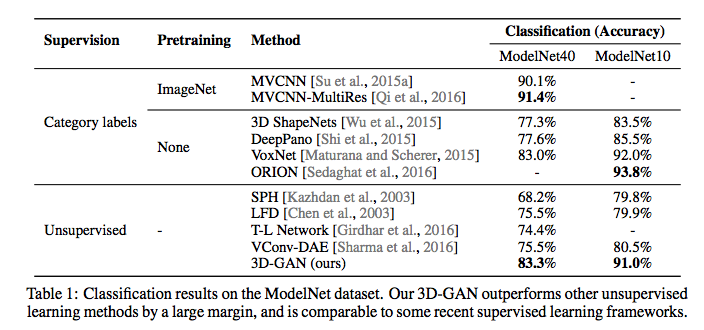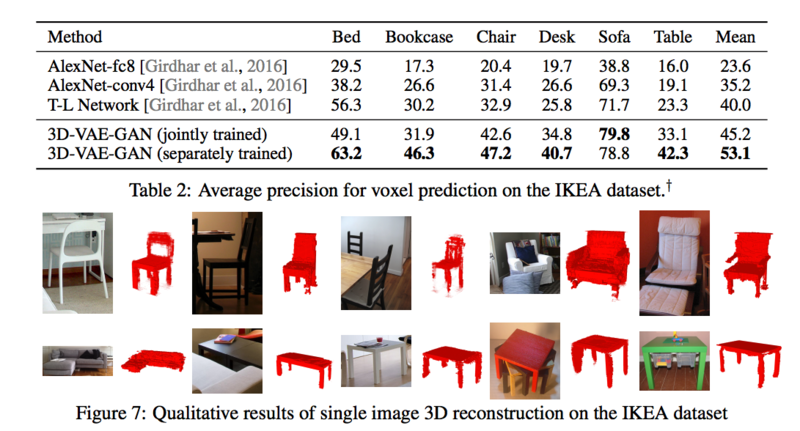STAT946F17/ Learning a Probabilistic Latent Space of Object Shapes via 3D GAN: Difference between revisions
No edit summary |
No edit summary |
||
| Line 25: | Line 25: | ||
===== Generator ===== | ===== Generator ===== | ||
[[File:---Users-a6karimi-Desktop-Deep_Learning_Course_Presentation_Images-Screen_Shot_2017-10-16_at_2.56.27_PM.png|800px]] | |||
===== Discriminator ===== | ===== Discriminator ===== | ||
===== Encoder ===== | ===== Encoder ===== | ||
| Line 36: | Line 38: | ||
The approach used in this paper is interesting in that it adaptively decides whether to train the network or not. Here, for each batch, D is only updated if its accuracy in the last batch is <= 80%. Additionally, the generator learning rate is set to 2.5 x 10e-3 whereas the discriminator learning rate is set to 10e-5. This further caps the speed of training for the discriminator relative to the generator. | The approach used in this paper is interesting in that it adaptively decides whether to train the network or not. Here, for each batch, D is only updated if its accuracy in the last batch is <= 80%. Additionally, the generator learning rate is set to 2.5 x 10e-3 whereas the discriminator learning rate is set to 10e-5. This further caps the speed of training for the discriminator relative to the generator. | ||
=== | === Evaluation === | ||
===== Qualitative results for 3D generated objects ===== | |||
For generation: | |||
* Sample a 200-dimensional vector following an i.i.d. Uniform distr over [0,1] | |||
* Render the largest connected component | |||
Compare with | |||
* 3D object synthesis from a probabilistic space [Wu et al., 2015] | |||
* Volumetric auto-encoders (because latent space is not restricted, we fit a Gaussian to the empirical latent space distribution) | |||
[[File:amirhk_eval_1.png|800px]] | |||
* Able to synthesize high-res 3D objects with detailed geometries | |||
* Objects are similar, but not identical to training samples → not memorizing | |||
===== Classification performance of learned representations w/o supervision ===== | |||
Typical way to evaluate representations learned without supervision is to use them as features for classification. | |||
Input: 3D object | |||
Output: feature vector (concatenated the responses of the 2nd, 3rd, 4th convolutional layers in the discriminator, w/ applied max-pooling of size {8,4,2}) | |||
Classifier: Linear SVM | |||
[[File:amirhk_eval_2.png|800px]] | |||
Train Data: ShapeNet | |||
Test Data: ModelNet {10, 40} | |||
=== | ===== 3D object reconstruction from a single image ===== | ||
Following previous work [Girdhar et al., 2016] the performance of 3D-VAE-GAN was evaluated on the IKEA dataset | |||
1039 objects centre-cropped from 759 images (supplied by author) | |||
Images captured in the wild, often w/ cluttered backgrounds and occluded | |||
6 categories: bed, bookcase, chair, desk, sofa, table | |||
Performance | |||
Single 3D-VAE-GAN trained on 6 categories | |||
Multiple 3D-VAE-GANs each trained on 1 category | |||
Align each prediction with GT over permutations, flips, and %10 translation | |||
[[File:amirhk_eval_3.png|800px]] | |||
= | = Future Work and Open questions = | ||
= Source = | = Source = | ||
Revision as of 15:04, 17 October 2017
Introduction
Related Work
Existing method
- Borrow parts from objects in existing CAD model libraries → realistic but not novel
- Learn deep object representations based on voxelized objects → fail to capture highly structured differences between 3D objects
- Mostly learn based on a supervised criterion
Methodology
Let us first review GANs...
3D-GANs
3D-GANs are a simple extension of GANs for 2D imagery. Here, the model is composed of a
- Generator (G): maps a 200-dimensional latent vector z, randomly sampled from a probabilistic latent space (U[0,1]), to a 64 x 64 x 64 cube, representing the object G(z) in voxel space.
- Discriminator (D): outputs a confidence value D(x ) of whether a 3D object input x input is real or synthetic
and a loss function L3D-GAN = log D(x ) + log( 1 - D( G(z ) ) )
3D-VAE-GANs
An extension of ...
Training and Results
Network Architecture
Generator
Discriminator
Encoder
Coupled Generator-Discriminator Training
Training GANs is tricky because in practice training a network to generate objects is more difficult than training a network to distinguish between real and fake samples. In other words, training the generator is harder than training the discriminator. Intuitively, it becomes difficult for the generator to extract signal for improvement from a discriminator that is way ahead, as all examples it generated would be correctly identified as synthetic with high confidence. This problem is compounded when we deal with 3D generated objects (compared to 2D) due to the higher dimensionality. There exists different strategies to overcome this challenge, some of which we saw in class:
- 1 D update every N G updates
- Capped gradient updates, where only a maximum gradient is propagated back through the network for the discriminator network, essentially capping how fast it can learn
The approach used in this paper is interesting in that it adaptively decides whether to train the network or not. Here, for each batch, D is only updated if its accuracy in the last batch is <= 80%. Additionally, the generator learning rate is set to 2.5 x 10e-3 whereas the discriminator learning rate is set to 10e-5. This further caps the speed of training for the discriminator relative to the generator.
Evaluation
Qualitative results for 3D generated objects
For generation:
- Sample a 200-dimensional vector following an i.i.d. Uniform distr over [0,1]
- Render the largest connected component
Compare with
- 3D object synthesis from a probabilistic space [Wu et al., 2015]
- Volumetric auto-encoders (because latent space is not restricted, we fit a Gaussian to the empirical latent space distribution)
- Able to synthesize high-res 3D objects with detailed geometries
- Objects are similar, but not identical to training samples → not memorizing
Classification performance of learned representations w/o supervision
Typical way to evaluate representations learned without supervision is to use them as features for classification. Input: 3D object Output: feature vector (concatenated the responses of the 2nd, 3rd, 4th convolutional layers in the discriminator, w/ applied max-pooling of size {8,4,2}) Classifier: Linear SVM
Train Data: ShapeNet Test Data: ModelNet {10, 40}
3D object reconstruction from a single image
Following previous work [Girdhar et al., 2016] the performance of 3D-VAE-GAN was evaluated on the IKEA dataset 1039 objects centre-cropped from 759 images (supplied by author) Images captured in the wild, often w/ cluttered backgrounds and occluded 6 categories: bed, bookcase, chair, desk, sofa, table Performance Single 3D-VAE-GAN trained on 6 categories Multiple 3D-VAE-GANs each trained on 1 category Align each prediction with GT over permutations, flips, and %10 translation
Future Work and Open questions
Source
Sutskever, I. Vinyals, O. & Le. Q. V. Sequence to sequence learning with neural networks. In Proc. Advances in Neural Information Processing Systems 27 3104–3112 (2014). <references />



